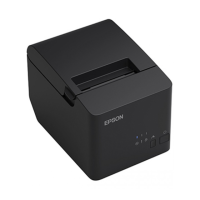
Do you have a question about the Epson TM-T20IIIL and is the answer not in the manual?
| Type | POS printer |
|---|---|
| Print technology | Thermal |
| Product color | Black |
| Mac operating systems supported | Mac OS X 10.12 Sierra, Mac OS X 10.13 High Sierra, Mac OS X 10.14 Mojave |
| Linux operating systems supported | Yes |
| Windows operating systems supported | Windows 10, Windows 7, Windows 8, Windows 8.1 |
| Maximum roll diameter | 80 mm |
| Printing media thickness | 53 - 75 µm |
| Connectivity technology | Wired |
| Wi-Fi | No |
| Internal memory | - MB |
| Built-in barcodes | CODABAR (NW-7), Code 39, Code 93, Code-128 Codabar Library, EAN13, EAN8, GS1 DataBar, GS1 DataBar Expanded, GS1 DataBar Limited, GS1 DataBar Omnidirectional, GS1 DataBar Truncated, GS1-128, MaxiCode, QR Code, UPC-A, UPC-E |
| Autocutter durability | 1.5 million cuts |
| Mean time between failures (MTBF) | 360000 h |
| AC input voltage | 100 - 240 V |
| Power source type | AC |
| AC input frequency | 50/60 Hz |
| Power consumption (printing) | 28.7 W |
| Depth | 192 mm |
|---|---|
| Width | 140 mm |
| Height | 137 mm |
| Weight | 1500 g |
Explains the manual's purpose for developers and engineers.
Details about the printer's capabilities and functions.
Details about available models and accessories.
Identifies and explains the printer's physical components and buttons.
Explains the meaning of the printer's status indicator lights.
Details the various ports available on the printer for connectivity.
Describes the printer's online and offline states.
Details errors that the printer can resolve automatically.
Explains errors that can be resolved by simple user actions.
Describes errors requiring professional service or advanced troubleshooting.
Provides a table showing LED status combinations and their meanings.
Information on non-volatile memory areas for storing user data and settings.
Outlines the sequential steps for installing the printer and peripherals.
Provides precautions and guidelines for physically installing the printer.
Explains how to connect the printer to a computer via USB or other interfaces.
Details the procedure for connecting the printer using a USB cable.
Describes how to connect the printer via a serial (RS-232) cable.
Explains how to connect the printer to a network using an Ethernet cable.
Provides instructions for connecting the printer to a power source.
Details how to connect a cash drawer to the printer.
Explains how to connect and set up an optional external buzzer.
Configuration options for printer functions via memory switches and utilities.
Explains various printer features like line feed, power saving, and print density.
Guides on entering and using various operational modes for settings and diagnostics.
Procedure to print product name, version, and status information.
Prints information about registered NV graphics.
Prints settings related to auto top/bottom logo printing.
Allows changing printer settings through interactive menus.
Resets printer settings and user-defined data to factory defaults.
Configures network and interface settings (Ethernet model only).
Displays transmitted data in hexadecimal and ASCII format for debugging.
Methods and tools for controlling printer functions via commands and SDKs.
Details the Epson original command system for POS printers.
Explains how to control the cash drawer using commands or drivers.
Describes how to control the optional external buzzer using commands or drivers.
Lists available development kits, drivers, and utilities for application development.
Details SDKs like OPOS ADK, JavaPOS ADK, and ePOS SDK.
Lists available printer drivers for different operating systems.
Describes utilities for managing printer settings and network configuration.
Guidelines for optimal printing of barcodes and 2D symbols.
Step-by-step instructions for loading and changing printer paper rolls.
Procedures for clearing paper jams safely.
Instructions for cleaning the printer case and thermal head/platen roller.
Steps to safely prepare the printer for shipping or moving.
Compares features and specifications with the previous TM-T20 model.
Comparison of printing and character specifications.
Details the speed differences between TM-T20IIIL and TM-T20.
Describes differences in the paper cutting mechanism.
Information on registering logos in NVRAM.
Confirms compatibility with existing TM-T20 drivers.
Enabling USB low power saving features.
Specifies the compatible paper width for the printer.
Explains the changes in IP address assignment for Ethernet models.
Instructions for using as a network printer with TM-i/DT.
Provides physical dimensions and weight for comparison with TM-T20.
Detailed technical specifications of the printer's hardware and capabilities.
Parameters related to printing method, speed, density, and character spacing.
Details on character sets, structures, sizes, and scaling.
Information on compatible paper types, sizes, and thickness.
Diagram and dimensions of the maximum printable area on the paper.
Illustrates positions for manual cutter, autocutter, and print dotline.
Specifies voltage, current, and power consumption ratings.
Details operating and storage temperature, humidity, vibration, and noise levels.
Provides final physical dimensions and weight of the printer.
Technical details for USB, Serial, and Ethernet interfaces.
Details on USB connector, transmission speed, and device classes.
Parameters for serial communication, including baud rate, parity, and handshake.
Explanation of signals for each pin on the serial connector.
Details on supported protocols and network parameters for Ethernet.
Reference to online resources for character code tables.
